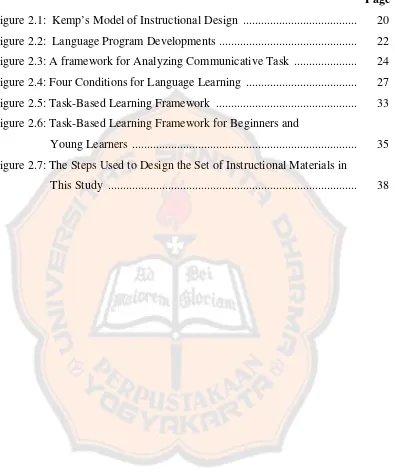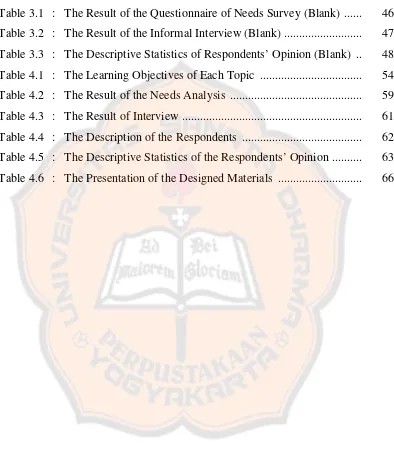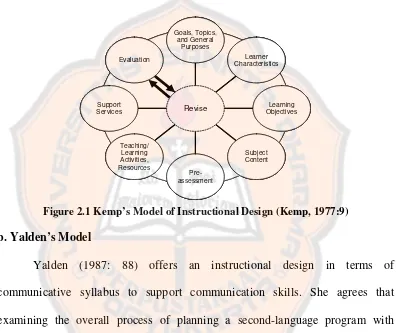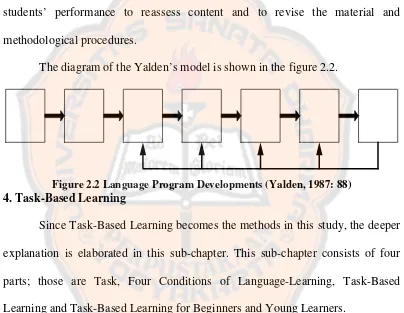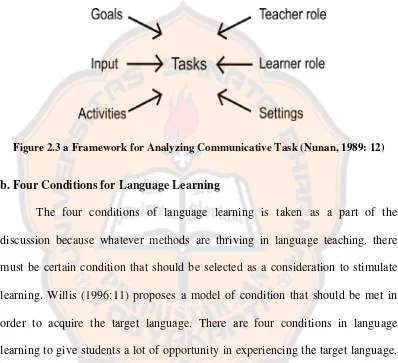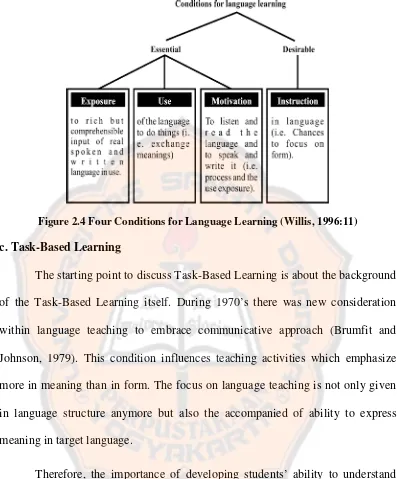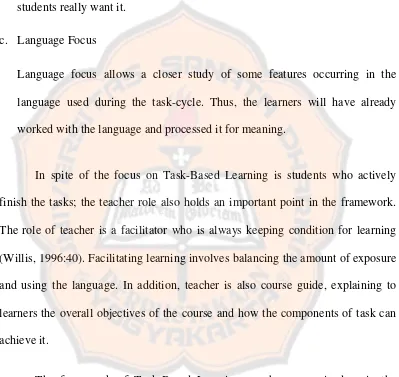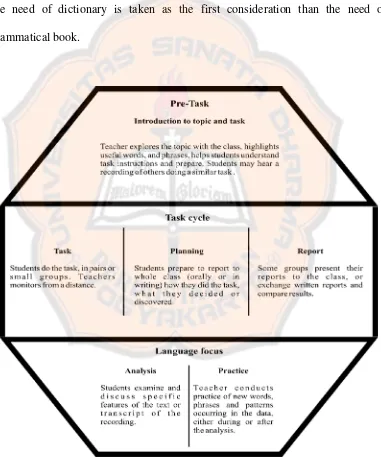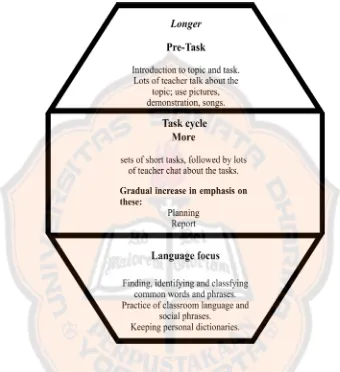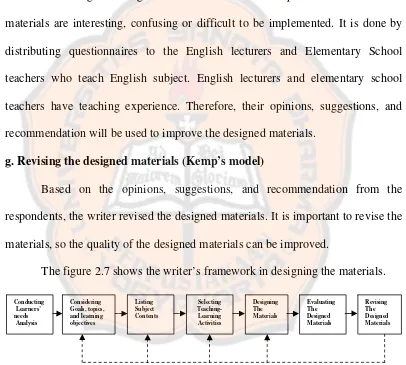DESIGNING A SET OF ENGLISH VOCABULARY MATERIALS FOR THE SECOND GRADE STUDENTS OF KANISIUS NOTOYUDAN ELEMENTARY SCHOOL IN YOGYAKARTA USING TASK-BASED
LEARNING
A Thesis
Presented as Partial Fulfillment of the Requirements to Obtain the Sarjana Pendidikan Degree
in English Language Education
by
Henry Koesasih Student Number: 011214097
ENGLISH LANGUAGE EDUCATION STUDY PROGRAM DEPARTMENT OF LANGUAGE AND ARTS EDUCATION FACULTY OF TEACHERS TRAINING AND EDUCATION
SANATA DHARMA UNIVERSITY YOGYAKARTA
A Sarjana Pendidikan Thesis on
DESIGNING A SET OF ENGLISH VOCABULARY MATERIALS FOR THE SECOND GRADE STUDENTS OF KANISIUS NOTOYUDAN ELEMENTARY SCHOOL IN YOGYAKARTA USING TASK-BASED
LEARNING
by
Henry Koesasih Student Number: 011214097
April 13, 2007
April 13, 2007
A Sarjana Pendidikan Thesis on
DESIGNING A SET OF ENGLISH VOCABULARY MATERIALS FOR THE SECOND GRADE STUDENTS OF KANISIUS NOTOYUDAN ELEMENTARY
SCHOOL IN YOGYAKARTA USING TASK-BASED LEARNING by
Henry Koesaih
Student Number: 011214097
Defended before the Board of Examiners on April 27, 2007
and Declared Acceptable
Board of Examiners Chair Person : Agustinus Hardi Prasetyo, S.Pd., M.A. Secretary : Drs. P. G. Purba, M.Pd.
Member : C. Tutyandari, S.Pd., M.Pd.
Member :F.X. Ouda Teda Ena, S.Pd., M.Pd. Member : Y. Veniranda, S.Pd., M.Hum.
STATEMENT OF WORK’S ORIGINALITY
I honestly declare that this thesis which I wrote does not contain the works or part of the works of other people, except those cited in the quotations and bibliography, as a scientific paper should.
Yogyakarta, April 27, 2007 The writer,
Henry Koesasih 011214097
ACKNOWLEDGEMENTS
First of all, I would like to thank Jesus Christ for always being by my side and giving me a chance to live with endless blessing, grace, and also power to
finish my study.
I would also thank people, whom help me in finishing this thesis. I realize
that without any help from them, I would never have finished my study.
Therefore, I would like to express my highest gratitude to my major sponsor, C. Tutyandari S.Pd., M.Pd., for her time, suggestions, kindness, and patience to help me finish my thesis, and my co-sponsor F.X. Ouda Teda Ena S.Pd., M.Pd., for his assistance and guidance on every word of my thesis. My appreciation also
goes to the teaching and secretariat staff in English Language Education Study
Program.
My next deepest gratitude goes to my mother, Theresiana Subintari. I would like to thank her for her hard work, endless prayers, support, patience and
love. I would also like to thank my brother, Antony Evenly S.Psi. I thank him for his support, affection and financial help so I was able to finish my study. I also
thank my sister, Chyntia Octaviana for her support during my study time. Moreover, I would like to express my deepest apology to my mother and brother
because I took too much time to finish my study.
My next gratitude goes to the Headmaster of Kanisius Notoyudan
Elementary School for giving me a chance to take the subject for my design. I
thank Mbak Nana and Monica Trias Arumi. I thank them for their advice, experience and idea that help me much finish this thesis.
I thank my friends, Ratih and Herpin for always being my best friends and for the great experience during study time. I knew and learnt so many things
dealing with life from them. I thank my friends Ale, Catur and Krisna. I thank them for always sharing me the experience and knowledge which are very useful
for me. I thank Cicil and Sanaha for always being my companion and giving me suggestions in finishing this thesis.
I also thank Sunny, Ratna, Tia, Ita, Pipit, Nucy, Jete, Yuke, Ayie, Michael, Thesa, Timmy and Damar for all beautiful and fun experiences.
My deepest gratitude also goes to my lovely Nur Rina Prihastuti. I thank her for her endless love, patience, prayers, time, and suggestions. It is impossible
for me to finish this thesis without her by my side. Moreover, I thank her for
always cheering me up when I am down and for always being my inspirations in
this life.
Last but not least, my gratitude also goes to PBI’ 01, my friends and my relatives, whom I cannot mention one by one, for the nice friendship we had together.
Henry Koesasih
‘
WHERE THERE IS A WILL,
THERE IS A WAY
’
(UNKNOWN)
T
T
T
H
H
H
I
I
I
S
S
S
T
T
T
H
H
H
E
E
E
S
S
S
I
I
I
S
S
S
I
I
I
S
S
S
D
D
D
E
E
E
D
D
D
I
I
I
C
C
C
A
A
A
T
T
T
E
E
E
D
D
D
T
T
T
O
O
O
:
:
:
J
JJEEESSSUUUSSSCCCHHHRRRIIISSSTTT M
MMYYYFFFAAAMMMIIILLLYYY M
MMYYYSSSEEELLLFFF A
AANNNDDDNNNIIINNNAAA
TABLE OF CONTENTS
Page
TITLE PAGE ... i
PAGE OF APPROVAL ... ii
PAGE OF ACCEPTANCE ... iii
STATEMENT OF WORK’S ORIGINALITY ... iv
PAGE OF DEDICATION ... v
ACKNOWLEDGMENT ... vi
TABLE OF CONTENTS ... viii
LIST OF FIGURES ... xi
LIST OF TABLES ... xii
ABSTRACT ... xiii
ABSTRAK ... xiv
CHAPTER I: INTRODUCTION ... 1
A. Background ... 1
B. Problem Identification ... 3
C. Problem Limitation ... 3
D. Problem Formulation ... 4
E. Research Objectives ... 4
F. Research Benefits ... 5
G. Definition of Terms ... 6
CHAPTER II: LITERATURE REVIEW ... 8
A. Theoretical Description ... 8
1. Teaching Learning Vocabulary ... 8
a.The Importance of Vocabulary ... 8
b.Vocabulary Selection ... 9
c.Teaching Techniques ... 10
d.Learning Vocabulary ... 11
2. Young Learners ... 12
a. The Characteristics of Young Learners in the Elementary School ... 13
b. Principles of Teaching Young Learners in the Elementary School ... 15
3. Instructional Design Models ... 17
a. Kemp’s Model ... 17
b. Yalden’s Model ... 20
4. Task-Based Learning ... 22
a. Task ... 22
b. Four Conditions for Language Learning ... 24
c. Task-Based Learning ... 27
d. Task-Based Learning for Beginners and Young Learners ... 32
B. Theoretical Framework ... 35
CHAPTER III: METHODOLOGY ... 39
A. Research Methods ... 39
1. Pre-design ... 39
2. Materials Development ... 40
3. Post-design ... 41
B. Respondents of the Research ... 41
1. Pre-Design Respondents ... 42
2. Post-Design Respondents ... 42
C. Instruments of the Research ... 43
1. Pre-Design Instruments ... 43
2. Post-Design Instruments ... 45
D. Data Gathering ... 45
E. Data Analysis ... 46
1. Pre-design as the Needs Survey ... 46
2. Post-design as the evaluation of
the designed materials ... 47
F. Research Procedures ... 49
CHAPTER IV: RESULTS AND DISCUSSION ... 51
A. The Steps in Designing the Vocabulary Materials ... 51
B. Survey Results ... 58
C. Discussion on the Designed Materials ... 65
D. The Presentation of the Designed Materials ... 66
CHAPTER V: CONCLUSION AND SUGGESTIONS ... 68
A. Conclusion ... 68
B. Suggestions ... 69
BIBLIOGRAPHY ... 71
APPENDICES ... 73
Appendix A : Permission Letter ... 74
Appendix B : Questionnaire for Elementary School Teachers ... 75
Appendix C : Interview Questions for the Kanisius Notoyudan’s Instructor ... 79
Appendix D : Designed Materials Evaluation Questionnaire ... 80
Appendix E : Gambaran Umum Materi ... 83
Appendix F : Lesson Plan ... 87
Appendix G : Teacher’s Hand Book ... 100
Appendix H : Designed Materials ... 121
LIST OF FIGURES
Page
Figure 2.1: Kemp’s Model of Instructional Design ... 20
Figure 2.2: Language Program Developments ... 22
Figure 2.3: A framework for Analyzing Communicative Task ... 24
Figure 2.4: Four Conditions for Language Learning ... 27
Figure 2.5: Task-Based Learning Framework ... 33
Figure 2.6: Task-Based Learning Framework for Beginners and Young Learners ... 35
Figure 2.7: The Steps Used to Design the Set of Instructional Materials in This Study ... 38
LIST OF TABLES
Page
Table 3.1 : The Result of the Questionnaire of Needs Survey (Blank) ... 46
Table 3.2 : The Result of the Informal Interview (Blank) ... 47
Table 3.3 : The Descriptive Statistics of Respondents’ Opinion (Blank) .. 48
Table 4.1 : The Learning Objectives of Each Topic ... 54
Table 4.2 : The Result of the Needs Analysis ... 59
Table 4.3 : The Result of Interview ... 61
Table 4.4 : The Description of the Respondents ... 62
Table 4.5 : The Descriptive Statistics of the Respondents’ Opinion ... 63
Table 4.6 : The Presentation of the Designed Materials ... 66
ABSTRACT
Koesasih, Henry. 2007. Designing a Set of English Vocabulary Materials for the Second Grade Students of Kanisius Notoyudan Elementary School in Yogyakarta Using Task-Based Learning. Yogyakarta: English Education Study Program, Sanata Dharma University.
This study aims to design a set of vocabulary materials for the second grade students of Kanisius Notoyudan elementary school in Yogyakarta using Task-Based Learning (TBL). There are two questions formulated in the problem formulation. The first question is about how to design a set of vocabulary materials for the second grade students of KanisiusNotoyudan elementary school in Yogyakarta using Task-Based Learning (TBL). The second question is related to the presentation of the designed materials. In order to answer the two questions, the writer conducted research for the learners’ need analysis and also designed materials evaluation by means of questionnaires.
The writer adapted some steps from Kemp, and Yalden’s instructional design models to construct a new model in order to answer the first question. The writer applied seven steps to develop this designed materials. They are 1) Conducting Learners Needs Analysis, 2) Considering Goals, Topics and Learning Objectives, 3) Listing Subject Content, 4) Selecting the Teaching and Learning Activities, 5) Designing the Materials, 6) Evaluating the Designed Materials, 8) Revising the Designed Materials.
To answer the second question, the writer presents the final version of the designed materials after making some revisions and improvements based on results of the designed materials evaluation survey. There are nine units presented in the designed materials. They are Good Morning My Friends, My A B C, Counting Numbers, My Colorful Balloons, Animals, My Favorite Fruits, Funny faces, My Happy Family and Review. Each unit consists of three parts except for the review as the last topic. They are Let’s begin!, Let’s practice and Let’s finish the lesson.
From the designed materials evaluation survey, the average point of the Mean (M) is 4.05. This result shows that the designed materials are acceptable and appropriate for the second grade students of Kanisius Notoyudan elementary school.
Finally, it is hoped that the designed materials will help the second grade students of Kanisius Notoyudan elementary school improve their English vocabulary mastery through the tasks and activities provided in the designed materials. The writer also hopes that the designed materials give contributions to the English teachers and the future researchers.
ABSTRAK
Koesasih, Henry. 2007. Designing a Set of English Vocabulary Materials for the Second Grade Students of Kanisius Notoyudan Elementary School in Yogyakarta Using Task-Based Learning. Yogyakarta: Program Pendidikan Bahasa Inggris, Universitas Sanata Dharma.
Studi ini bertujuan untuk merancang materi pembelajaran vocabulary untuk siswa kelas dua SD Kanisius Notoyudan di Yogyakarta dengan menggunakan Pembelajaran Berbasis Tugas (PBT). Ada dua permasalahan yang dikemukakan dalam studi ini. Permasalahan pertama adalah bagaimana merancang materi pembelajaran kosakata untuk siswa kelas dua SD Kanisius Notoyudan dengan menggunakan Pembelajaran Berbasis Tugas (PBT). Permasalahan kedua adalah bagaimana menyajikan materi tersebut.
Penulis mengadaptasi beberapa langkah dalam model Kemp dan Yalden untuk merancang satu model instruksional baru untuk menjawab permasalahan pertama. Penulis menerapkan tujuh langkah yang diambil dari kedua dalam model tersebut. Langkah-langkah tersebut adalah survey kebutuhan, menentukan tujuan dan topik pengajaran, menentukan isi pengajaran, memilih aktivitas pembelajaran, merancang materi, evaluasi dan memperbaiki materi dari hasil evaluasi.
Untuk menjawab permasalahan yang kedua penulis mempersembahkan versi akhir dari design materi yang telah direvisi dan dikembangkan berdasarkan hasil dari evaluasi materi tersebut. Materi ini terdiri dari delapan unit, dan unit-unit tersebut adalah Good Morning my Friends, My A B C, Counting Numbers, My Colorful Balloons, Animals, My Favorite Fruits, Funny faces, My Happy Family dan Review. Setiap unit terdiri dari tiga bagian kecuali pada review sebagai topik terakhir. Bagian-bagian tersebut adalah Let’s begin, Let’s practice
dan Let’s finish the lesson.
Dari hasil survei evaluasi materi, nilai rata-rata Mean (M) adalah 4.05. Hasil tersebut menunjukkan bahwa desain materi tersebut dapat diterima dan digunakan untuk mengajarkan kosakata pada siswa kelas dua SD Kanisius Notoyudan.
Akhirnya, rancangan materi tersebut diharapkan dapat membantu siswa kelas dua SD Kanisius Notoyudan untuk menyelesaikan tugas, menyanyikan lagu dan memainkan permainan untuk meningkatkan penguasaan kosakata dalam Bahasa Inggris. Penulis juga berharap desain materi ini juga memberikan kontribusi pada guru bahasa Inggris dan para peneliti yang akan melakukan penilitian lebih lanjut.
CHAPTER I INTRODUCTION
In this study, the writer designs a set of vocabulary materials for the
second grade of Kanisius Notoyudan elementary school using Task-based Learning. The writer divides this first chapter, into seven parts. Those are
Background, Problem Identification, Problem Limitation, Problem Formulation,
Research Objectives, Research Benefits and Definition of Terms.
A. Background
As a system of sounds and words, a language holds the most important
aspect to communicate feeling and thought (Oxford, 1991: 233).Thus, it will be
very difficult for human beings to understand each other without language. One of
the languages that is widely used and considered important is English.
Knowing the importance of English, Indonesian government puts English
as the first foreign language to be taught in formal schools. It is expected that by
learning English in school, the students will grow into more secure, more
contributory and more total member of the society (Broughton at all, 2001: 10).
The Indonesian government has attempted to put English as a local content
that begins from the fourth grade of elementary school. On the other hand, there
are schools which take their own policy to teach English from the first grade or
even kindergarten. The policy is taken to give students longer chance in learning
Another important reason to start teaching English in the early level of
education is that the success of a second language learning is often related to the
age of the learners. Students in the elementary school belong to young learners
who are still in critical period. Critical period is a period between births to puberty
(age 1 up to 13) when children must learn a language or it becomes much more
difficult to learn a language after this critical period (Oksaar, 1983: 147). Within
this period, the left hemisphere of the brain is still opened. The left hemisphere of
human brain is normally the location of the abilities needed for the use of a
language. Hence, it is easier to acquire a language for children when they are still
in the critical period.
Dealing with teaching children, it is important to pay attention on words or
vocabulary. Carol as quoted in McKeown book (1987: 1) agrees that the primary
task of the school related to language learning is to teach vocabulary. The earlier
children learn vocabulary, the easier they learn the language. Therefore, having a
large amount of vocabulary can support the learners to learn the other elements
and skills of language.
Starting to teach English vocabulary for young learners must be followed
by understanding their mental growth. It is taken as important consideration
because children require special technique by playing and memorization (Lado,
1967:54). Developing attractive materials which is suitable with students’ mental
growth can build students’ motivation in learning English.
Providing attractive material for young learners cannot be separated from
developing tasks in the classroom because learners participate and encounter
By completing a task, the students have a great opportunity to treat their second
language acquisition and knowledge.
Based on the fact that a set of vocabulary materials for young learners
which uses task-based learning is still rarely used, the writer would like to design
a set of English instructional materials to teach vocabulary for the second grade of
elementary school students, who are still considered as young learners using
Task-Based Learning. The result of the study hopefully can be used to enrich the
existing materials and can fulfill students’ needs in learning vocabulary especially
children in the second grade of elementary school.
B. Problem Identification
Dealing with children, teacher should understand that they are easily
disturbed and difficult to concentrate. Children prefer to do whatever they want to
do than to listen to the teacher’s explanation. Teacher’s explanation is considered
boring. Once students get bored, they start to ignore the lesson. Thus, it is
important to avoid boredom and keep students’ attention to learn English.
Designing interesting materials which are expected to build students’
interest and motivation is important. Combining attractive activities which
emphasizes on vocabulary mastery by giving the students interesting tasks is to
reduce students’ boredom and to build their motivation in learning English.
Therefore, the activities and the tasks should be simple and easy to be understood
by children.
C. Problem Limitation
The focus of this research is on designing a set of English vocabulary
Learning. The materials hopefully provide activities and tasks that are suitable
with the mental growth of children in the second grade of elementary school. The
second grade of Kanisius Notoyudan elementary school students are chosen, since this school starts to teach English in the kindergarten level. To know the students’
needs, interests, difficulties, and also abilities that should be developed, the writer
distributed questionnaires to ten English instructors who teach young learners in
the elementary school from the first up to third grades, interviewed English
instructors to gather information about their way to teach and did class
observation to get the experience in teaching young learners in the second grade
of elementary school.
D. Problem Formulation
Dealing with designing the English instructional materials for teaching
English vocabulary to the second grade of elementary school using Task-Based
Instruction, the problems in this study can be formulated as follows:
1. How is a set of vocabulary instructional materials using Task-Based
Learning for the second grade of Kanisius Notoyudan elementary school students designed?
2. What does the designed set of vocabulary instructional materials using
Task-Based Learning for the second grade of Kanisius Notoyudan
elementary school students look like?
E. Research Objectives
This research is conducted to answer the questions stated in the problem
1. To find out the way how to design a set of instructional vocabulary
materials using Task-Based Learning that is suitable for the second
grade of Kanisius Notoyudan elementary school students.
2. To design the instructional vocabulary materials using Task-Based
Learning that is suitable for the second grade of Kanisius Notoyudan
elementary school students.
F. Research Benefits
This research is expected to give clear answers to the problems stated in
the problem formulation. Hopefully, it will also give some benefits especially for:
1. Children in the second grade of elementary school
As a local content, it will help them know English earlier. The
designed materials are hopefully to give them new experience in
learning English especially in improving their vocabulary mastery so
that they will be ready to learn English in the higher level.
2. Second Grade of Elementary School Teachers
Teachers who are likely to be involved in teaching English may
consider it as their reference. It can be used as an alternative to teach
English to their students.
3. Other researchers
The researcher expects that this designed materials will be useful for
those who want to do similar research, they can use it as their
G. Definitions of Terms
1. Vocabulary
According to Hornby in the Oxford Advanced Learners’ Dictionary of Current English (1991:461), vocabulary is the total number of words that make up a language and list of words with their meaning especially which accompanies a
textbook in a foreign language. In this study, vocabulary refers to the list of words
which closely relates to the children’s daily life.
2. Instructional Materials Design
Walter and Reiser (1989, 62 -67) state that the instructional materials
design is as a system which consists of sub-systems to support the overall goal of
a system. In this study, instructional materials design means a process that
consists of interrelated parts to the achieve goals.
3. Elementary School
Peraturan Pemerintah No. 28 Tahun 1990 states that elementary school is a unit form of basic education which runs a six-year education program. In this
study, elementary school is defined as a unit form of basic education where the
students have their first formal and compulsory education.
4. Second Grade of Elementary School Students
Second grade of elementary school students means the learners who
occupy the second level or class based on their ability and age. In this study,
second grade of elementary school students means children who study in the
5. Task-Based Learning
Task-Based Learning is one of the developments of communicative
approach which takes task as the central in a supportive methodological
framework (Willis, 1996: 1). In this study, Task-Based Learning is used as a
CHAPTER II LITERATURE REVIEW
In this chapter, the writer discusses the related review as the basis of this
study. This chapter is divided into two main parts. The first part is theoretical
description and the second part is theoretical framework.
A. Theoretical Description
This section is related to the theories that will support this study. In this
section, the writer emphasizes the theories about 1) Teaching and Learning
Vocabulary, 2) Elementary School Students, 3) Instructional Design Model and 4)
Task-Based Learning.
1. Teaching Learning Vocabulary
Since vocabulary becomes the concern in this study, the writer explains about the importance of vocabulary teaching learning especially for children in
this first sub-chapter. There are four parts within this sub-chapter; those are The
Importance of Vocabulary, Vocabulary Selection, Teaching Techniques, and
Learning Vocabulary.
a. The Importance of Vocabulary
Vocabulary means a total number of words in a language (Oxford, 1993:
461). Thus, vocabulary learning becomes a central to language acquisition
whether the language is the first, second or foreign. Furthermore, the interest
which emphasizes on the need of systematic and principle approach to vocabulary
by both teachers and learners in foreign language learning have grown rapidly in
Moreover, students should learn very large vocabulary when they start to
acquire a language because learning a language means learning its vocabulary
(Gass, 1999: 325). It is because learning vocabulary deals with lexical items, a
number of things and even meaning on the target language. However, it is
important for teachers to manage the learners in doing something with vocabulary
which is going to be learned since it becomes the biggest part of the meaning of
any language (Fan, 2003: 222).
b. Vocabulary Selection
The first priority in vocabulary teaching is to focus on which words that
are to be studied (Read, 2004: 148). Thus, teacher has to do selection towards the
words that are going to be taught. It is not an easy job because there are
differences in linguistic analysis in which the words are based. Moreover, it is
better for teacher to select and to classify the words in different categories, for
instance verbs are usually more difficult than nouns, and abstract nouns are more
difficult than concrete nouns.
Since the subjects of the study are young learners in the second grade of
elementary school, the vocabulary mainly will be focused on the concrete nouns.
Concrete nouns are easy to be learnt for children because teacher could perform
the realia or the picture so that students could have a clear meaning and
description of the words. Moreover, presenting the concrete objects will help
students to touch, feel, or even smell that it will make the learning process more
c. Teaching Techniques
According to Decarrico (2001: 288), there are two techniques in teaching
vocabulary; those are presenting words in the context and teaching a list of words
through word association. Presenting vocabulary through context is important in
order to provide clues to meaning and to give the students multiple exposures to
words which are being learned. Teaching vocabulary in a list of words is rarely
used since it is boring.
In addition, there are some techniques that are commonly used in the
beginner’s class, those are: using repetition, using word-list, using pictures, using
realia, using story, using songs, and using games.
1) Using repetition
The teachers usually read or pronounce the words first and the students will
repeat it. Then, the students write down the words and the teachers explain
about the meaning.
2) Using word-list
The teacher gives a list of words or vocabulary and its ‘equivalent’ in the
native tongue. Memorizing and repeating dominate the learning process.
3) Using picture
Teacher usually brings some pictures of objects with the names of the objects
written down below the picture. After the students understand, the teachers
will ask the students to mention the name of the picture.
4) Using realia
Facing the real objects is a good way to help students to have clear meaning in
5) Using story
Story is a good technique to teach vocabulary. It will help students to
understand the vocabulary in the context. Therefore, the teacher has to be
careful in selecting the story, so it will not burden the students.
6) Using songs
The atmosphere of the class will be full of joy by introducing songs in the
class. The songs make the students feel relaxed and enjoy the learning.
Teachers build comprehension about vocabulary through song indirectly.
7) Using games
Naturally, children like to play games. It will be an interesting technique to
teach children by using games.
Combining the techniques above could create an interesting atmosphere in
the classroom, and to reduce boredom for children.
d. Learning Vocabulary
Learning as a process by which information is obtained, stored, retrieved
and used cannot be separated from what is being learned (Rubin, 1987: 29).
Learning vocabulary means a process to obtain, store, retrieve and use the total
number of words in a language. Within the vocabulary learning process, there are
two kinds of learning processes that should be understood by teachers, those are
explicit learning and implicit learning.
1) Explicit Learning
In explicit vocabulary learning, students involve in the activities that
are done primarily to enrich students’ vocabulary knowledge (Decarrico, 2001:
287). This explicit learning creates students’ intentional learning.
The goal of creating students’ intentional learning is to build a large
recognition of vocabulary, to integrate new words with old and to provide a
number of words through memorization in a list of words. Though it seems to be
old-fashioned in the context of task-based learning, Hulstijn (2001: 275- 285)
argues that direct words recognition as one component of vocabulary learning
especially for beginning and intermediate level.
2) Implicit Learning
Implicit learning brings an incidental vocabulary learning that occurs when
the mind is focused elsewhere such as on understanding context or using language
for communicative purpose (Decarrico, 2001: 287). In this learning process,
learners do not focus on tasks which directly refer to the vocabulary acquisition.
Learning vocabulary from the context and providing communicative tasks
are to give a large amount of input to acquire vocabulary. Moreover, the exposure
from the context and the tasks given will facilitate the learners to get higher
vocabulary acquisition indirectly.
2. Young Learners
The discussion about children as young learners is taken in this
sub-chapter because this study is purposed for them. This sub-sub-chapter will be divided
into two parts; those are The Characteristics of Young Learners in the Elementary
a. The Characteristics of Young Learners in the Elementary School
According to Cole (1956: 124) children in the elementary school grow and
develop during six years in school when children are in the age of 6 – 12 years
old. Within this period, there is a big advance of children in both mentally and
physically (Mehl, 1950: 20). They grow from infancy to childhood, a period when
children enter into a world that they have to make their own decision and solve
their own problem.
Children in the elementary school are categorized into two grades. The
first three years is called primary grade and second three years is called the
intermediate grade. Since the subjects of this study directly relate to children in
the first grade, the explanation emphasizes more on the characteristics of children
in the first grade. Cole (1956: 125-132) says that children in the primary grades
have specific characteristics namely physical characteristics, intellectual
characteristics, emotional characteristics, and social characteristics which change
in a great advance. The explanations of those characteristics are presented as
follows:
1) Physical characteristics
The physical characteristics of children in the primary grades are that
children grow rapidly in size and proportion of parts of the body. During the first
three years, children grow seven inches taller and fifteen pounds heavier.
Although, basically, children in this age are easily exhausted because their
nervous and muscular controls are poor, they are very active in doing any kinds of
2) Intellectual characteristics
The intellectual characteristics of the children in this period are that they
still have immature mind with a strong fantasy. It is because children in this
period only meet a few people and their knowledge of reality is weak. Another
important consideration about the children’s intellectual characteristics is that they
are easy to have a feeling of insecurity. It makes children like to hear the same
story, to play the same games and to do the same things over again. They feel
secure to do the same things than to do something which is unfamiliar. Children in
this period are also alert and interested in school work, but they are ignorant,
undisciplined, and uncertain of themselves.
3) Emotional characteristics
The most obvious characteristic is the lack of self control and inhibition.
Children like to do whatever they want to do immediately, for instance, children
suddenly cry when they want to cry. Moreover, children have exaggerated fears of
all kinds and sorts of things such as winds, thunder, lighting, rain and other
natural phenomena. It is common since they have a little knowledge about
anything.
4) Social characteristics
During this period children are changing from an individualistic dependent
being to an independent socialized individual (Mehl: 1950). Children in this grade
share two quite contradicting characteristics. Children are highly individualistic in
both interest and desires; on the other hand they are also highly independent upon
the school environment in which they do not know what to do. On the contrary,
they find something new that they need to ask the teachers about the things.
Children in this period also have a great curiosity as the indicator of the
cognitive development. They are interested in learning all kind of things and they
want to know as many facts as possible about as many different things as possible.
Within this period, children are classified in the concrete operational stage which
spans the years from 7 to 11 in which a major for any point in cognitive
development (Berk, 1994: 243).
b. Principles of Teaching Young Learners in the Elementary School
Basically, elementary school students are expected to get an important
basic knowledge to be used in their adolescences (Hurlock, 1960: 146). Therefore,
teachers who are responsible to teach in this level should have an understanding of
children’s growth and development.
Cole (1956: 317-321) states that there are three methods that can be
applied in teaching in the elementary school students, those are study
environment, directions for studying and memorizing new words.
1) Study Environment
The first and the main requirement of study is development of
environment which is favorable to mental efforts. There are two principles which
relate to the study environment. Firstly, teacher should eliminate competing
activities in the classroom. Competing activity will distract children because their
attentions are poor. Secondly, students in the primary grade should not whisper
while other children are supposed to be studying. Whispering is distracting and
2) Directions for studying
It is important to give a clear direction for the children to study. It covers
the teacher’s expectation toward the students’ activity. Giving assignment
becomes an important part in teaching learning activities. Teacher can give the
students a perfectly clear direction to what they have to do through the
assignment.
3) Memorizing new words
Memorizing is commonly used in the primary grade because there are at
least three advantages from it. Firstly, teachers could arrange the instructional
materials in order to make students memorize in a way they will be used.
Secondly, the arrangement of instructional materials enables the students to drill
themselves. Lastly, there will be variations of a number of repetitions given to
each item depend on the difficulty of each items.
Teachers also need to pay attention to the specific rules in the elementary
school (Cole, 1956: 320-321) and the rules are:
a) Do not allow any competing activities to be going on in a classroom in which
the children are supposed to study.
b) Do not allow whispering.
c) Give assignments clearly to make students know and understand exactly what
they have to do and what the teachers expect them to do.
d) Make the minimum assignment so low that everyone can reach it and also add
e) Have the students memorize in isolation those facts which may occur in any
number of combinations.
In addition, teacher should understand that children in the elementary
school are also language learners who try to make sense of things without
understanding everything (Willis, 1996:127). Children enjoy playing games and
doing activity-based learning. Children also like to play the same games and to
hear the same stories by repetition. Therefore, providing a lot of variety of
activities to keep children’s interest and to build their motivation in learning
language is important because they are still difficult to concentrate.
3. Instructional Design Models
In conducting this study, the writer puts two instructional models in order
to make the material effective and successful. Thus, this sub-chapter explains two
instructional design models from Kemp and Yalden that are used by the writer.
This sub-chapter consists of two parts; those are Kemp’s Model and Yalden’s
Model.
a. Kemp’s Model
The first model is taken from Kemp’s model. Kemp (1977: 6) considers
instructional design process is a complex process which must operate in a
coherent manner to achieve success in implementing the design. Hence, he
suggests eight parts of instructional design plan as follows:
Part 1: Consider goals, topics and general purposes for teaching each topic.
All educations programs are based on broadly stated goals. The goal is important
to recognize changes in the needs and interests of the learners. After recognizing
of the program and the basis for the instruction. Then, general purposes are listed
to express the planners’ aims of each topic.
Part 2: Enumerate the important characteristics of the learners for whom the instruction is to be designed.
In this part, recognizing students as individual learners is important. Thus,
teachers should know the characteristics of the learners both physically and
psychologically as a group of individual. Teachers must obtain as much
information about the learners’ capabilities, needs and interests.
Part 3: Specify the learning objectives to be achieved in terms of measurable students’ behavioral outcomes.
This part explains that learning is outcome of the instruction. It requires active
efforts by the learners. Therefore, objectives must be stated in the terms of
activities that will help students in their learning process. Objectives tell students
goals that must be attained, ideas and skills involved in the instruction given and
the expectation of behavior types during evaluation.
Part 4: List the subject content that supports each objective.
Subject content is a part of students’ learning experience. The content must
closely relate to the objectives and students’ needs. The subject content consists of
the selection and organizing of specific knowledge, skills, and attitudinal factors
of any topic.
Determining the student’s background and presenting level of knowledge about
the topic are important. It is necessary to eliminate, modify or add objectives after
analyzing the result of pre-assessment. The pre-assessment is also used to know
what extent each student has acquired for studying each topic and what students
have mastered about the subject to be studied.
Part 6: Select the teaching learning activities
Selecting the learning and teaching activities will treat the subject content in order
to help the students meet the objectives. In this part, it is important to determine
the most efficient and effective methods and then select the materials to provide
learning experience for students to achieve the objectives.
Part 7: Coordinate such support services
There are many interrelated elements in any instructional design that should be
considered carefully and each needs careful consideration during the appropriate
planning step. For instance, budget, personnel, facilities, equipment, and
schedules to carry out the instructional plan. These supporting services must be
considered at the same time when the instructional plan and the materials are
made.
Part 8: Evaluation student’s learning
This is the result of the instructional design plan. Measurement of the learning
outcome is done here. Evaluation student’s learning in terms of their
accomplishment of objectives, with a view to revising and reevaluating any
Those eight parts above are a flexible process (Kemp, 1977: 9). A designer
does not need to start from the first part. Beginning the process with whichever
part which is ready can be done by the designer. Every part is interrelated and
cannot be spitted up because there is interdependence among each element. This
model is a unity. The diagram of Kemp’s models is elaborated in the figure 2.1.
Evaluation Support Services Teaching/ Learning Activities, Resources Pre-assessment Subject Content Learning Objectives Learner Characteristics Goals, Topics, and General Purposes Revise Evaluation Support Services Teaching/ Learning Activities, Resources Pre-assessment Subject Content Learning Objectives Learner Characteristics Goals, Topics, and General Purposes Revise Evaluation Support Services Teaching/ Learning Activities, Resources Pre-assessment Subject Content Learning Objectives Learner Characteristics Goals, Topics, and General Purposes Revise Evaluation Support Services Teaching/ Learning Activities, Resources Pre-assessment Subject Content Learning Objectives Learner Characteristics Goals, Topics, and General Purposes Revise
Figure 2.1 Kemp’s Model of Instructional Design (Kemp, 1977:9)
b. Yalden’s Model
Yalden (1987: 88) offers an instructional design in terms of
communicative syllabus to support communication skills. She agrees that
examining the overall process of planning a second-language program with
syllabus as a very important part of the process. Thus, designer can understand the
process of instructional design. The stages of processing an instructional design
are:
1) Need survey
Need survey is conducted to analyze the learners’ needs. It identifies the
identification of the communication requirement, personal needs, motivations,
2) Description of Purpose
The syllabus designer will get direction for describing the purpose of the program
after conducting the need survey. The purpose of the language program can be
investigated from the two considerations of students’ characteristics and students’
skills on entry to and exit from the program.
3) Selection and development of syllabus program
The choice of syllabus type is done when the general category of a language
program has been decided. It can be a proposed range of syllabus from a structural
syllabus to a completely learner-centered.
4) Production of the Proto-syllabus
At this stage description of the contents is conducted in accordance with the type
of syllabus. The designer should also remember the purpose of the program that
the specification of syllabus contents will be taken accordingly.
5) Development of the pedagogical syllabus
Development of specification teaching, learning and testing approaches is done in
this stage. Therefore, the production of proto-syllabus will be completely
developed.
6) Development and implementation of classroom procedures
In this stage, development of classroom procedures should include selection of
classroom procedures, preparation of lesson plan, and preparation of weekly
schedules. It should bring a significant change in the teacher’s role. The teacher
should regard himself as a facilitator than a leader. The classroom procedures,
7) Evaluation
Evaluation can be done at every stage that enables the designer to revise the type
and content of the syllabus. It consists of the evaluation of the students, the
evaluation of the program, the evaluation of the teaching.
8) The recycling stage
The last stage is important to measure the congruence between goal set and
students’ performance to reassess content and to revise the material and
methodological procedures.
The diagram of the Yalden’s model is shown in the figure 2.2.
Figure 2.2 Language Program Developments (Yalden, 1987: 88)
4. Task-Based Learning
Since Task-Based Learning becomes the methods in this study, the deeper
explanation is elaborated in this sub-chapter. This sub-chapter consists of four
parts; those are Task, Four Conditions of Language-Learning, Task-Based
Learning and Task-Based Learning for Beginners and Young Learners.
a. Task
It is important to start the discussion by giving the general opinion about
what the meaning of task is. Nunan (1989, 5-6) states two different kinds of tasks,
those are: real-world task and pedagogic task.
1. “Real-world task” as non-technical and non-linguistic task. A task is a piece of
instance: painting a fence, buying a pair of shoes and taking a hotel
reservation.
2. “Pedagogic task” as what the learners will do in the classroom. A task is an
activity or action which is carried out as a result of processing or
understanding language, for instance: drawing a map while listening to the
teacher’s instruction in the classroom.
The term of pedagogic task is used further because this study is related to
the classroom activities which are done by students. Concerning with the
pedagogic task, it is important for teacher to understand the importance of task. It
means that teachers have to understand how to create good tasks and its role since
it can not be separated from the teaching learning activities in the classroom.
Moreover, there are, at least two important reasons for teachers to design a
good tasks. Firstly, a task requires the students to use language in order to attain
the objective (Skehan, 2003: 3). Secondly, a task also provides learners big
opportunity to interact with language use in the natural context (Larsen-freeman,
2000: 144).
In addition, Nunan (1987:10) also argues the term of communicative task
as a piece of classroom work which involves learners in comprehending,
manipulating, producing, or interacting in the target language while their attention
is principally focused on meaning than form. There are components which build
the communicative task; those are goals, input, activities, teacher role, learner role
and setting. A goal becomes the general intentions behind any learning tasks.
Input is data which might be verbal or non-verbal that learners work with in
Activities are stated based on the input data for students in accomplishing
the goals of the tasks. Teacher and learner role are the part in which teacher and
learner are expected to play in carrying out the tasks. Setting of the task refers to
the classroom arrangement specified and implied in the task given.
Figure 2.3 a Framework for Analyzing Communicative Task (Nunan, 1989: 12)
b. Four Conditions for Language Learning
The four conditions of language learning is taken as a part of the
discussion because whatever methods are thriving in language teaching, there
must be certain condition that should be selected as a consideration to stimulate
learning. Willis (1996:11) proposes a model of condition that should be met in
order to acquire the target language. There are four conditions in language
learning to give students a lot of opportunity in experiencing the target language,
those are: language exposure, language use, motivation, and instructions.
Language exposure, language use, and motivation are essential. Without
one or even two of those three components, students will not have big opportunity
in experiencing the target language. The instruction is considered as desirable
because students can learn a language outside the classroom. The further
1) Language Exposure
Giving language exposure to students is to make sense in whatever inputs
given. It might involve listening, reading or both. Moreover, the learning process
within this language exposure might be conscious or subconscious. The exposure
gives students example in getting meaning and observing how others express the
meanings that students want to be able to express.
Language teacher needs to pay careful attention in selecting inputs. The
quality of the input is taken as the first consideration, for example giving the
students variety of types of language use. It will give students experience toward
the language variety that may increase students’ motivation.
2) Language Use
The goal of most methods in foreign or second language teaching is to
teach the students to communicate in the target language (Larsen- Freeman, 2000:
121). Thus, it is impossible not to give students chance to make the real use of the
target language itself.
The internalized process in using the language helps students to create
their own understanding. Students should be put in a setting they are risk-takers
(Breen and Cadlin, 1980 as quoted in Wisnu 2006:15). The process of making an
error is considered as natural. The more important point is that students
experience the target language in variety of situation.
3) Motivation
Motivation is needed in whatever people want to get their goal. In
instrumental or both (Willis, 1996:14). Integrative means the motivation is built to
get involved in the community where the target language is spoken purely.
Instrumental means target language as a means to get certain goals.
On the other hand, teacher usually finds that students do not have long
personal motivation. Learning English is considered as a subject that should be
followed as the part of curriculum. Therefore, teacher has to select topics and
activities that serve to motivate in the short term.
The activities are chosen to stimulate interest and involvement by students.
The involvement of students is expected to bring success and satisfaction in the
students’ development process. Once students get satisfaction through their own
effort, it influences the students to participate next time.
4) Instruction
Instruction is desirable since it does not change the learners’
developmental change (Willis, 1996: 15). Although instruction can, both speed up
the rate of students’ language development and increase students’ attainment, the
participation of sufficient exposure and suitable condition are really needed.
The benefit of instruction is that students notice specific feature of the
target language. It can give students the opportunity to process grammatical and
lexical patterns. (Willis: ibid). Moreover, instruction aids learning if it is intended
for controlled performance.
Figure 2.4 Four Conditions for Language Learning (Willis, 1996:11)
c. Task-Based Learning
The starting point to discuss Task-Based Learning is about the background
of the Task-Based Learning itself. During 1970’s there was new consideration
within language teaching to embrace communicative approach (Brumfit and
Johnson, 1979). This condition influences teaching activities which emphasize
more in meaning than in form. The focus on language teaching is not only given
in language structure anymore but also the accompanied of ability to express
meaning in target language.
Therefore, the importance of developing students’ ability to understand
and to express meaning in the target language become the core of language
teaching pedagogy as the goal of communicative competence (Savignon, 2001:
13). In order to achieve the communicative competence, task-based learning
appears as development of Communicative Language Teaching which the stress is
given in providing learners with natural context for language use
Moreover, Task-Based Learning creates how tasks can be used as the
central focus in a methodological framework to create a real purpose for language
use. Students prepare for the tasks, report back after the tasks, and then study the
language that arises naturally out of the task cycle and its accompanying materials
(Willis, 1996:1).
The concern of Task-Based Learning puts on the language learning, and
task appears for the problem solving negotiation between knowledge that learners
hold and acquire new knowledge (Cadlin and Murphy, 1987:1). The teaching
techniques which are used in task-based learning are not very different from
ordinary mainstream language teaching. The differences lie in the ordering and
weighting the activities, there is a greater amount of students’ activity.
Task-Based Learning provides the students with the motivation to improve and to build
meaning by the language they already have.
The process of completing the task gives students a big amount of
opportunity to interact. The interaction functions to facilitate language acquisition
when students have to understand each other and to express their own meaning.
The exchanging information through the interaction enables students to interact
not only with the task but also with other students. Interaction among the students
can be facilitated by making group in finishing the tasks. Moreover, the use of
group work in finishing task also brings advantages, as follows (Willis, 1996:35):
a) It gives learners confidence to try out whatever language they know, or think
they know, in the relative privacy of a pair or small group, without fear of
b) It gives the learners experience of spontaneous interaction, which involves
composing what the students want to say in real time, formulating phrases and
units of meaning, while listening to what is being said.
c) It gives learners a chance to benefit from noticing how others express similar
meanings.
d) It gives learners chance to practice negotiating turns to speak and to respond
the questions.
e) It engages learners in using language purposefully and co-operatively,
concentrating on building meaning not just using language for display
purposes.
f) It makes learners participate in a complete interaction. Negotiating openings
and closings, new stages or changes of directions.
Another important feature of Task-Based Learning is that students are free
to choose whatever language form to convey meaning (Willis, 1996: 24). Within
this process, teacher must state a specified objective that should be achieved as the
outcomes of accomplishing task. The result of this process emphasizes on
understanding and conveying meaning in order to complete the task successfully.
The needs of accomplishing the task with specified objectives and
outcomes ask teachers to clarify the kind of tasks. Thus, Willis (1996: 28) offers
two kinds of tasks, those are close task and open task.
a) Close task is a task which is highly structured and has very specific goals. The
instructions are very precise and the information is restricted. There is only
to find seven differences between two pictures and write down in note form
with two minutes as time limit.
b) Open task is a task which is more loosely structured with less specific goals.
This kind of task will give more challenge for students to think or even to
predict the purpose of the task. On the other hand, teacher is difficult to state a
specific objective through this kind of task. For example: comparing
memories of childhood journeys, or exchanging anecdotes on a theme.
Willis (1996: 26) also classifies several types of tasks in which there are
several processes within the tasks, those are: listing, ordering and sorting,
comparing, problem solving, sharing personal experience, and creative tasks.
a) Listing
Listing tasks purposes to motivate learners in expressing their ideas. The
processes which are involved, those are: (1) Brainstorming to draw learners on
their own knowledge and experience and (2) Fact finding to find things out by
asking each others, or referring to books or movie given.
b) Ordering and Sorting
There are four processes which are involved are: (1) Sequencing items, actions
or events in a logical or chronological order, (2) Ranking items according to
personal values or specified criteria, (3) Categorizing items in given groups or
grouping them under given headings, and (4) Classifying items in different
ways, where the categories themselves are not given.
The processes which are involved are: (1) Matching to identify specific points
and relate them to each other, (2) Finding similarities and things in common,
and (3) Finding differences.
d) Problem Solving
The process involves learners’ intellectual and reasoning powers. Moreover,
the process and time scale mostly depend on the type and complexity of the
problems.
e) Sharing Personal Experience
The process encourages learners to talk freely about their personal experience.
f) Creative Tasks
The process is built by the combination of the tasks to produce a creative work
by the learners
An important aspect in discussing Task-Based Learning is about its
framework because only giving many tasks over and over is not the basic idea of
Task-Based Learning. The tasks are given as the process within the framework.
There are three phases in the Task-Based Learning framework and the further
explanation can be described, as follows:
a. Pre-Task
This phase is usually the shortest stage in the framework. It introduces the
class to the topic, activating topic-related words and phrases. Pre-activity is
used to explore the topic of language which actively involves learners, gives
b. Task-cycle
This stage offers the learners the chance to use whatever language they
already know in order to carry out the task. Then, the students improve that
language, under teachers’ guidance. Feedback from teacher comes when the
students really want it.
c. Language Focus
Language focus allows a closer study of some features occurring in the
language used during the task-cycle. Thus, the learners will have already
worked with the language and processed it for meaning.
In spite of the focus on Task-Based Learning is students who actively
finish the tasks; the teacher role also holds an important point in the framework.
The role of teacher is a facilitator who is always keeping condition for learning
(Willis, 1996:40). Facilitating learning involves balancing the amount of exposure
and using the language. In addition, teacher is also course guide, explaining to
learners the overall objectives of the course and how the components of task can
achieve it.
The framework of Task-Based Learning can be summarized as in the figure 2.5 (can be seen in the page 33).
d. Task-Based Learning for Beginners and Young Learners
Since the designed material is purposed for children, it is important to
know how Task-Based Learning can be useful for children. As stated in the
the task itself. Thus, students learn to acquire a language in the natural context by
doing the activities and tasks.
The importance of acquiring words and phrases becomes the main
consideration in The Task-Based Learning for beginners before they start to learn
grammar (Willis, 1996: 118). She adds that when someone visits foreign country,
the need of dictionary is taken as the first consideration than the need of
grammatical book.
In addition, children learn a language through listening and then begin to
produce simple words and phrases. Therefore, tasks for children should provide
opportunity to listen and participate in meaning-focused interaction in order to
help them acquire new language more naturally.
Giving students a lot of exposure to new language and making the
exposure comprehensible are important in accordance with beginners. Otherwise,
beginners still feel shy to use the new language in front of other students. Thus,
teacher has to consider affective factor which appreciates whatever language they
have. The use of group work and its advantages as stated in the previous
sub-chapter also help beginners to reduce fear in learning language.
In addition, Willis (ibid) also states that in teaching beginners, teacher
gives priorities in, first, establishing a relaxed, and anxiety free atmosphere in the
classroom. Second, providing a lot of exposure in which learners can make
approximate sense. Third, building on what they know, but without expecting
perfection. Fourth, avoiding to force students speaking at the first time. Fifth,
reassuring students of their progress, and generally boosting their confidence.
Since teaching children is different from teaching adults, the framework of
Task-Based Learning is also different. The differences are put on; firstly, exposure
as one important component in language learning gets a larger proportion. It
makes the pre-task is longer and the task-cycle is shorter. Secondly, the cycle
consists of short tasks rather the long one because students are less confident.
The framework of Task-Based Learning for Beginners and Young
Learners can be summarized as in the figure 2.6.
Figure 2.6 Task-Based Learning Frameworks for Beginners and Young Learners
(Willis, 1996: 116)
B. Theoretical Framework
In this sub-chapter, the writer presents his own instructional design. The
instructional design is based on the adaptation of Kemp’s and Yalden’s model.
Those two instructional designs are used because there are many interrelated parts
in designing the materials and in using only one design model that are considered
The learners’ needs analysis step is taken from Yalden’s model because
Kemp’s model does not use this step. The next steps about considering goals,
topics, and learning objectives, listing subject content, selecting teaching and
learning activities, evaluating and revising the designed materials are taken from
Kemp’s model. Basically, the reason for choosing Kemp’s model is because each
step in the Kemp’s instructional design process is flexible. It means that the writer
could start and use any steps to make the designed materials which are ready and
appropriate with the situation and condition. The further explanation of those
seven steps that are used by the writer is explained as follows:
a. Conducting the learners’ needs analysis (Yalden’s model)
The first step in this study is conducting the learners’ analysis to know the
learners’ interest, needs, and difficulties in learning English vocabulary. Within
this step, the writer also wants to know the general condition of teaching learning
in the second grade of elementary school. It is important for the writer, so that the
materials which are designed can be suitable with students’ needs.
b. Considering goals, topics, general purposes and learning objectives (Kemp’s model)
Understanding the learners’ interest, needs and difficulties is important to
decide the goals of the designed materials. The goal of this study is to help the
second grade of elementary school students in mastering vocabulary through
teaching learning activities which are designed by the writer. The basis of
selecting the topics is from result of the interview with the second grade of
questionnaire for ten elementary schools instructors who teach in the first up to
the third grades.
After considering the goals and topics, the writer formulated the general
purposes and the learning objectives in the form of students’ activities in order to
achieve the goals of the designed materials. In order to adjust to the new
curriculum for elementary school students, the writer changes the terms of goals
to competency standard, general purposes to basic competency and learning
objectives to achievement indicators.
c.. Listing Subject Content (Kemp’s model)
Listing the subject content is important to achieve the objective that is
suitable with students’ needs. It will provide students learning experience (Kemp,
1977: 43). The subject content for each topic is decided based on the objective and
students’ needs.
d. Selecting teaching and learning activities (Kemp’s Model)
The next step after getting the information about learners’ characteristics
and choosing the goals, topics, general purposes and learning objectives is
selecting the teaching-learning activities which can support the students in
mastering the vocabulary.
Dealing with the task-based learning as the method in this study, the writer
considers Willis’ theory that states that the task can be used as the interaction for
students with the second language that they have acquired. Therefore, the
task-based learning framework for beginners and young learners are involved in
e. Designing the materials
In this step, the writer designed the materials based on the result of
learners’ needs analysis. It combines with the Task-Based framework for
beginners and young learners as the methods.
f. Evaluating the designed materials (Kemp’s model)
Evaluating the designed materials is the next step to know whether the
materials are interesting, confusing or difficult to be implemented. It is done by
distributing questionnaires to the English lecturers and Elementary School
teachers who teach English subject. English lecturers and elementary school
teachers have teaching experience. Therefore, their opinions, suggestions, and
recommendation will be used to improve the designed materials.
g. Revising the designed materials (Kemp’s model)
Based on the opinions, suggestions, and recommendation from the
respondents, the writer revised the designed materials. It is important to revise the
materials, so the quality of the designed materials can be improved.
The figure 2.7 shows the writer’s framework in designing the materials.
Revising The Designed Materials Evaluating The Designed Materials Designing The Materials Selecting Teaching- Learning Activities Listing Subject Contents Considering Goals, topics, and learning objectives Conducting Learners’ needs Analysis
CHAPTER III METHODOLOGY
This chapter discusses the research methodology that was used to answer
tw
